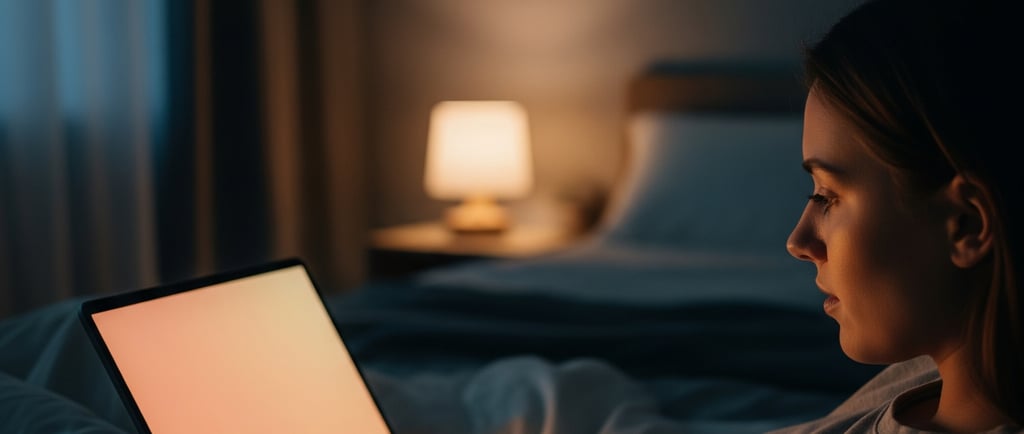AI technology in monitoring near progress - Blue light blocking screens - are they effective?
2/10/20257 min read


Introduction to Blue Light and Its Effects
Blue light is a specific range of the visible light spectrum, characterized by its short wavelength and high energy. It is emitted by various sources, including the sun, fluorescent and LED lighting, and digital screens such as smartphones, tablets, and computers. As these devices have become omnipresent in our daily routines, the amount of blue light exposure has increased significantly, which has raised concerns regarding its potential effects on human health.
Research has indicated that prolonged exposure to blue light, particularly at nighttime, may contribute to visual fatigue and sleep disturbances. Visual fatigue arises due to the overstimulation of the retina caused by extended screen time, leading to symptoms such as dry eyes, blurred vision, and headaches. As individuals engage in continuous interaction with screens, the need to blink decreases, exacerbating these symptoms and causing discomfort. Moreover, the blue light emitted by screens can suppress the production of melatonin, the hormone responsible for regulating sleep cycles, making it more difficult to fall asleep and maintain a restful night.
The growing concern surrounding blue light has prompted discussions about the importance of monitoring exposure levels, especially in an environment where digital devices dominate communication and work. With people spending a significant portion of their day engaged with screens, understanding the implications of blue light exposure and finding ways to mitigate its adverse effects is becoming increasingly crucial. As we delve deeper into the relationship between blue light and health, it is essential to consider various strategies and technologies, including the role of AI in monitoring and assessing exposure levels, to safeguard our well-being in this digital age.
What Are Blue Light Blocking Screens?
Blue light blocking screens are specialized display filters designed to mitigate the potential adverse effects of blue light emitted from digital screens. Blue light, which is part of the visible light spectrum, is known for its high energy and short wavelength. While exposure to natural blue light can assist in regulating circadian rhythms and promote alertness during the day, excessive exposure, particularly from screens, has been linked to various ocular discomforts and potential long-term eye damage.
To combat these issues, blue light blocking screens employ a range of technologies, both in hardware and software formats. Hardware solutions typically involve physical filter screens placed over the device’s display. These filters are designed to absorb or reflect certain wavelengths of blue light, thus diminishing the amount that reaches the user’s eyes. Such screens can either be integrated into the device during manufacturing or add-on filters that can be applied externally to existing screens, offering users a flexible solution to reduce detrimental blue light exposure.
On the software front, various applications and settings have been developed to adjust the color temperature of displays dynamically. By shifting the colors emitted by screens towards warmer tones, software solutions effectively limit the blue light without compromising the overall viewing experience. Available across multiple platforms, these settings can be easily toggled, allowing users to personalize their digital environments according to their comfort levels and time of day.
Today’s market offers several options for blue light blocking screens, catering to different devices, such as smartphones, tablets, computer monitors, and televisions. With enhanced awareness of blue light's implications on eye health, these products are gaining popularity, emphasizing the need for both technological innovation and user education regarding digital eye strain and effective screen protection.
Current AI Technologies Used for Monitoring Blue Light Exposure
Recent advancements in artificial intelligence (AI) have enabled the development of sophisticated technologies that effectively monitor blue light exposure. These technologies encompass various sensor systems and data analysis methodologies designed to provide real-time insights into how individuals interact with screens that emit blue light. A critical component in this monitoring process involves the use of wearable devices equipped with specially designed sensors. These sensors can measure light intensity and track exposure levels over time, enabling users to gain a clearer understanding of their blue light exposure habits.
Additionally, AI algorithms play a pivotal role in analyzing the data collected by these sensors. By employing machine learning techniques, these algorithms can identify patterns in user behavior, such as screen time duration, specific usage times, and the types of activities engaged in while using electronic devices. This computational approach allows for more personalized recommendations and interventions aimed at reducing excessive blue light exposure. Thus, users can be better informed about optimal screen usage practices, leading to improved eye health and overall well-being.
Examples of AI applications in this field are already showing promise. Some smartphone manufacturers have begun integrating blue light monitoring features into their devices. These features utilize AI to adjust display settings based on the estimated blue light exposure of the user, particularly during evening hours when potential sleep disruption is a concern. Furthermore, apps designed for this purpose leverage AI to send alerts or reminders to users when they exceed recommended exposure thresholds, effectively promoting healthier screen habits.
In essence, the intersection of AI technology and blue light monitoring provides critical tools for individuals seeking to minimize their exposure and mitigate the potential adverse effects associated with prolonged screen usage. The continuous innovation in this domain holds substantial promise for promoting better eye health and enhancing user experiences in an increasingly digital world.
Effectiveness of Blue Light Blocking Screens: Research and Findings
In recent years, the proliferation of digital screens has sparked considerable interest in the effectiveness of blue light blocking screens. Research in this area primarily focuses on the impact of blue light emitted by devices, such as smartphones and laptops, on eye health and overall well-being. Several studies have aimed to investigate whether blue light blocking screens can significantly reduce eye strain and improve sleep quality.
One prominent study published in the Journal of Ophthalmology examined the relationship between screen time and symptoms of digital eye strain, including discomfort and visual fatigue. The findings suggested that individuals using blue light filtering screens reported fewer symptoms of eye fatigue compared to those using standard screens. This indicates a potential benefit of blue light blocking technology in alleviating discomfort associated with prolonged screen exposure.
Another significant body of research explored the effects of blue light on sleep patterns. A study conducted by researchers at Harvard University emphasized that exposure to blue light, particularly in the evening, can disrupt the body's natural circadian rhythms. The findings highlight that blue light blocking screens, when used before bedtime, might be effective in promoting better sleep quality by reducing the intensity of blue light exposure during crucial evening hours.
Expert opinions on this matter vary; while some ophthalmologists advocate for the use of blue light blocking screens as a preventative measure against digital eye strain, others emphasize the need for further research to definitively quantify their effectiveness. Overall, while the evidence suggests potential benefits, experts recommend a holistic approach, including regular breaks from screen time, proper lighting, and eye care routines. This balanced perspective reflects the current state of research, which presents a nuanced view of blue light blocking screens and their effectiveness.
Limitations of Blue Light Blocking Screens and AI Monitoring
While blue light blocking screens and AI monitoring technologies have seen significant advancements, they are not without limitations. First and foremost, the effectiveness of blue light blocking screens can vary widely among individuals. Factors such as specific eye conditions, ambient lighting, and even the duration of screen usage can affect how well these screens reduce the impact of blue light exposure. Consequently, while some users may experience a reduction in eye strain and improved sleep quality, others may find minimal benefits. This variability can lead to differing opinions on the necessity and effectiveness of blue light blocking screens among users.
In addition, AI monitoring technologies, while promising in their ability to track and assess user interactions with screens, are not entirely devoid of challenges. One primary concern is the potential for misinterpretation of the data generated by these systems. Users may misconstrue feedback regarding blue light exposure, leading them to make uninformed decisions about their screen usage or blue light blocking needs. Furthermore, individuals may experience psychological effects stemming from the reliance on technology for monitoring their habits, potentially causing anxiety if they perceive their usage as excessive based on AI assessments.
Moreover, both blue light blocking screens and AI monitoring technologies can fall short of addressing broader issues related to screen time and overall digital well-being. For instance, while these solutions may reduce the harmful effects of blue light, they do not inherently encourage healthy screen habits or awareness surrounding digital consumption. When integrating such technologies into daily routines, it is essential to consider the limitations that these tools inherently possess, and to understand that they should complement, rather than replace, healthy screen usage practices.
Consumer Perspectives: What Users Are Saying
The rise of blue light blocking screens has been met with considerable interest from consumers, particularly as awareness of the potential negative effects of blue light on eye health grows. Many users express a sense of relief after incorporating these screens into their daily routines, with testimonials highlighting a noticeable reduction in eye strain, especially during prolonged periods of device usage. Consumers frequently report feeling less fatigued and experiencing improved sleep quality, which aligns with research suggesting that blue light exposure can interfere with natural sleep patterns.
A significant number of users commend the integration of AI technology in monitoring blue light blocking screens. Reviewers note that these AI-driven tools provide real-time data on blue light exposure levels, empowering users to make informed decisions about their screen time. This capability not only enhances the perceived effectiveness of the screens but also fosters a greater understanding of individual usage patterns and their associated impacts. Several testimonials mention that receiving alerts when blue light levels exceed recommended thresholds has encouraged them to take regular breaks, further mitigating potential adverse effects.
Conclusions and Future Directions
The exploration of AI technology in the realm of blue light blocking screens has revealed significant insights into its effectiveness in monitoring and assessing user interactions with these devices. It is evident that the integration of artificial intelligence not only aids in understanding the efficacy of blue light blocking solutions but also plays a pivotal role in optimizing user experience and health outcomes. The findings indicate that consumers benefit from enhanced visual comfort and reduced eye strain when utilizing screens equipped with modern blocking technology. Health professionals stand to gain from these developments, as they can better inform patients about the advantages related to prolonged screen use and the potential risks associated with blue light exposure.
Crucially, the implications of this blending of AI technology with blue light blocking screens extend beyond mere consumer satisfaction. They may also shape new guidelines and practices in healthcare, especially in the context of preventive measures against digital eye strain. The data produced by AI monitoring systems can provide invaluable insights for ongoing research and development efforts in both screen technology and user health. These collaborative efforts must focus on creating easily accessible devices that are tailored to individual needs, encouraging widespread acceptance and usage of blue light blocking solutions.
As we look to the future, there are several areas for potential advancement. Research could explore more refined algorithms that enhance real-time feedback during screen use, allowing users to adjust their habits accordingly. Additionally, incorporating machine learning models that predict an individual’s susceptibility to blue light exposure may improve the recommendations provided by health professionals. Ultimately, these future directions will not only deepen our understanding of AI technology’s role but also promote innovation in user-focused health solutions, paving the way for improved visual health in our increasingly digital world.
